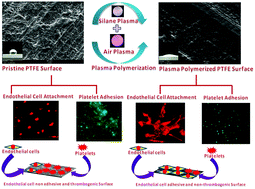Non-equilibrium organosilane plasma polymerization for modulating the surface of PTFE towards potential blood contact applications†
Abstract
We report a novel and facile organosilane plasma polymerization method designed to improve the surface characteristics of poly(tetrafluoroethylene) (PTFE). We hypothesized that the polymerized silane coating would provide an adhesive surface for endothelial cell proliferation due to a large number of surface hydroxyl groups, while the large polymer networks on the surface of PTFE would hinder platelet attachment. The plasma polymerized PTFE surfaces were then systematically characterized via different analytical techniques such as FTIR, XPS, XRD, Contact angle, and SEM. The key finding of the characterization is the time-dependent deposition of an organosilane layer on the surface of PTFE. This layer was found to provide favorable surface properties to PTFE such as a very high surface oxygen content, high hydrophilicity and improved surface mechanics. Additionally, in vitro cellular studies were conducted to determine the bio-interface properties of the plasma-treated and untreated PTFE. The important results of these experiments were rapid endothelial cell growth and decreased platelet attachment on the plasma-treated PTFE compared to untreated PTFE. Thus, this new surface modification technique could potentially address the current challenges associated with PTFE for blood contact applications, specifically poor endothelial cell growth and risk of thrombosis.



 Please wait while we load your content...
Please wait while we load your content...
